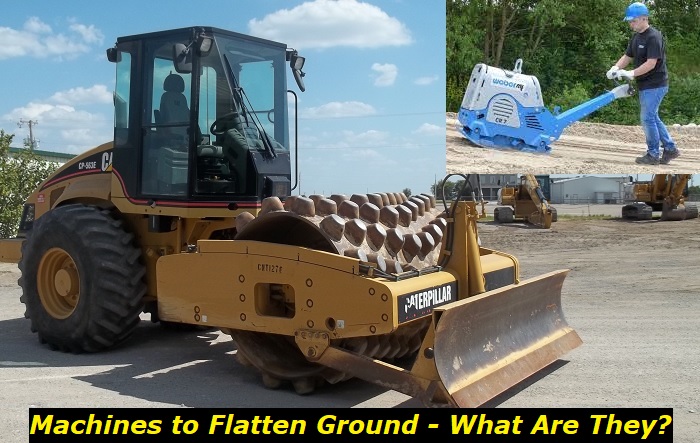Machine to Flatten Ground: Types, Names, and Ways to Use
The primary purpose of ground flattening is to create a level surface. However, creating a flat surface by flattening the ground is helpful for several other reasons. For example, flattening ground helps create a solid foundation for various construction projects, including building and road construction. Flattening the ground can also help reduce erosion and improve drainage for agricultural and landscaping applications.
For very small-scale work, something as simple as a rake, level, and shovel might be all you need. However, we are thinking bigger. Here we want to look at machines that can help you scale up the process of flattening the ground. This article will name and examine different types of machines and how we can use them.

Machines To Flatten Ground
The type of work you want to do and the ground characteristics may require using different equipment to flatten an area. To simplify the process, we want to quickly consider two areas of ground flattening that may come into play, grading and soil compaction.
This is not to say grading and compaction are all there is to flattening ground or that these are the only procedures one might require. However, these two procedures are common in many ground-flattening projects. So, for brevity and easy categorization, we will look at machines that can help flatten the ground through these processes.
Grading
Grading within the context of flattening ground is manipulating slopes and contours on the ground to manufacture a desired land surface gradient. Grading typically involves the use of heavy machines like bulldozers and graders. Grading is essential in ground flattening, creating a level and evenly sloped surface.
Evenly sloped grounds are necessary for ensuring ground stability and proper drainage. There are different types of grading, including landscape, architectural, regrading, rough, finish, and final grading.
Types Of Grading Machines
There are different types of grading machines, and they suit different needs and situations. Also, these machines are not mutually exclusive. They are usable together in various stages of soil grading. While we do not touch on every type of machine that can grade soil, we touch on some notable ones.
1) Bulldozers
A bulldozer is heavy machinery with multiple applications, including grading and ground flattening. The blade in front of the bulldozer is useful in various grading applications. With a bulldozer, you can push and move various materials. Professionals use bulldozers to create level surfaces for roads, railways, and other structures. Also, bulldozers help move dirt and gravel to make slopes and other features.
You can also use a bulldozer to clear debris and obstacles on construction sites. Further, bulldozers can also function to apply finishing touches to already graded surfaces. However, bulldozers are not the best choice for precise work that reduces damage to the nearby environment. Some popular bulldozer manufacturers are Caterpillar, John Deere, CASE, Komatsu, and Liebherr.
You can use a bulldozer for ground flattening and grading in the following ways:
- Creating level ground surfaces for other construction jobs like road building
- Moving dirt and gravel to manufacture slopes
- Removing obstacles and debris in construction sites
- Preparing the ground for landscaping
- Landscape land, create hills, valleys, and more
2) Motor Graders
A motor grader is a large piece of equipment that construction companies use to create flat surfaces for roads. They can level dirt, gravel, and other materials. Motor graders excel at flat surface creation for highways, road quality scarification, and reshaping. Also, motor graders are great for drainage ditch creation. Komatsu, Caterpillar, John Deere, and Champion are leading makers of motor graders.
The ways in which you can use a motor grader include:
- Road Grading and level surface creation
- Landscaping for lawns, agricultural use, patios, and more
- Snow removal from roads and lots
- Preparing soil for construction
3) Wheel Tractor Scraper
A wheel tractor scraper is a heavy machine that removes and transports material from a burrowing area to a site before soil compaction. A wheel tractor scraper is an earth movement tool in the ground flattening process. Top global wheel tractor scraper manufacturers include Caterpillar, Westrac, Terra Cat, and Enorossi.
The ways in which you can use a wheel tractor scraper in grading and ground flattening include:
- Pushing and
- Pulling dirt and gravel around to create level surfaces
4) Skid Steer Loaders
The machines we previously mentioned for grading are heavy equipment that works best in large-scale projects. Skid steer loaders are different, as they are compact machines that will work excellently in small environments to grade and level a surface. Residential lots, landscaping, and backfilling are projects where a skid steer effectively grades the ground surface.
As a caveat, skid steers may leave obvious track marks, especially on softer ground. Popular skid steer loader brands include Bobcat, Kubota, JCB, Komatsu, John Deere, Caterpillar, and CASE.
Skid steers are versatile machines that are usable for various tasks. Yet for ground flattening and grading, you can use them in the following ways:
- Leveling surfaces by moving dirt and gravel around
- Creating slopes
- Pushing materials into holes to fill them
- Removing, piling, and loading debris
Soil Compaction
Soil compaction exerts mechanical force to press soil particles together and minimize voids or airspaces between them. Soil compaction can help increase the soil's load-bearing capacity, reduce settlement, improve drainage, and minimize erosion. Also, soil compaction can improve soil stability and prevent problems like landslides.
Compaction can be vital in the ground flattening process, depending on your needs and surface characteristics. Soil compaction is useful in construction, agriculture, and landscaping.
Types Of Soil Compaction Machines
You can use many machines for soil compaction, which suit different use cases and situations. There are three types of compaction machines, rollers, plates, and rammers. We will consider at least one of each below.
1) Smooth Drum Roller
These are large pieces of equipment that utilize vibration, static pressure, and concentrated impact for soil compaction. The smooth drum roller is a type of roller compactor. It uses its smooth drum to compact soil, including hard materials like clay and granular materials like gravel, rocks, asphalt, and sand. Construction professionals use this machine to make flat and smooth surfaces.
There are two types of smooth drum rollers, single and double. The double drum roller has two steel drums compared to the single drum roller, which has one with tires at the back. Important smooth drum roller manufacturers include Caterpillar, Bomag, Volvo CE, Wirtgen, and Dynapac.
Some ways to use Smooth drum rollers include:
- Compacting subgrades
- Compacting asphalt pavements
- Compacting backfill
- Smoothing surfaces
2) Padfoot Compactor
Like smooth drum rollers, padfoot compactors use vibration and static pressure to compact materials. They are also roller compactors. But unlike the smooth drum rollers, they have a series of padfoot to compact soil, gravel, rocks, and asphalt. The padfoot is mounted on a roller frame that gets towed by a tractor or similar machines that support it. Bomag, Sakai America, Caterpillar, Case, Ammann, and Hamm are popular manufacturers of Padfoot compactors in North America.
Padfoot compactors share uses with smooth drum rollers. Still, unlike smooth drum rollers that exert a concentrated force, the padfoot distributes the machine's weight over a large area. As such, the padfoot excels at compacting granular materials, while smooth drum rollers are better at compacting hard materials like clay and gravel.
3) Plate Compactor
We are moving away from the large roller compactors with this one. A plate compactor, or plate tamper, is soil compacting equipment that works effectively in more confined spaces like parking lots, driveways, and repairs. Also, plate compactors are more suitable for shallow compaction than larger compaction machines. Plus, depending on your location, they are cheaper and possibly easier to source for purchase or rent. Manufacturers of plate compactors include Bomag, Dynapac, Yardmax, and Wacker Neuson.
Plate compactors support the same purposes as padfoots and drum rollers, albeit at a smaller scale and in more restricted spaces.
4) Pneumatic Tire Rollers
Pneumatic Tire Rollers (PTR) are self-propelling compaction machines that utilize pneumatic tires to compact soil, gravel, and more. Pneumatic tires are made of rubber filled with air. When driven over a surface, the tire compresses the air, creating a force that compacts the materials.
PTR can work on a variety of materials and are relatively easy to use and affordable. Well-known PTR manufacturers include; Ammann, Bomag, Hamm, Dynapac, and XCMG.
The nature of PTR compaction makes them ideal for compacting granular materials like sand and gravel. Also, they are great for surface sealing and compaction of thin lifts.
You can use PTR similarly to the other compacting machines mentioned so far.
5) Power Rammer
A power rammer is a small compactor for compacting light soil and small areas like trenches and ditches. Power rammers are typically lightweight and can be operated by machine or hand. They use a reciprocating piston to compact materials. The piston is created from steel. Three types of power rammers exist: dropping weight, pneumatic, and combustion. Power rammer manufacturers include the likes of Wacker Neuson, BOMAG, Weber, and Mustang.
You can use power rammers to:
- Flatten soil
- Pavement and road repair
- Compacting subgrades
- Compacting asphalt pavements
- Compacting backfill
- Construct trenches and foundations
Conclusion
Ground flattening is crucial to creating level surfaces in construction, agriculture, and landscaping. Grading and soil compaction are two standard processes in ground flattening. Grading of surface involves manipulating slopes and contours using heavy machineries like bulldozers, graders, and wheel tractor scrapers. Grading machines help to create a level and evenly sloped surfaces.
On the other hand, soil compaction involves applying mechanical force to reduce the presence of void or air spaces in soil particles. Soil compaction machines can be rollers, compactors, and rammers, and we discussed at least one of each in this article. These machines help improve soil stability, bearing capacity, and drainage. The different grading and compaction machines have their unique uses and applications. For ground flattening, choosing the appropriate machines depends on the specifics of your project and ground characteristics.

Add comment